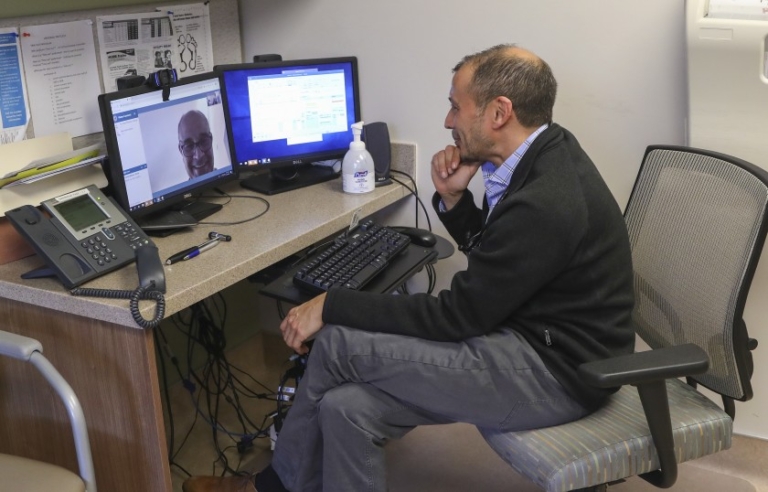How Much Do Doctors Get Paid for Telemedicine
/in About Telemedicine /by Telemedicine.com
How much do doctors get paid for telemedicine? The telehealth medical field has been rapidly expanding over the past couple of years as many clinicians and patients alike have realised exactly how beneficial this service can be. It has become regularly used by patients in rural areas as well as by those who might not have the time, money or transportation to get to a traditional in-person appointment. Telehealth services are incredibly important for individuals who do not want to risk being exposed to new germs in office waiting rooms or examination rooms.
Despite this exponential growth, however, many physicians are left wondering exactly how competitive this field is and whether or not it can compete with in-person physician jobs. They often wonder if it is worth leaving their current job in order to pursue a career in telehealth and does it really offer a real long-term career growth trajectory? In this article we will help you break down exactly what telehealth is, what the typical salary looks like, what variables may affect your salary and whether this job could be a real possibility in order to improve your career.
Telehealth Physicians
How much do doctors get paid for telemedicine? Telehealth is a unique way of meshing the traditional medical field with today’s cutting-edge technology. It is used to help patients access high-quality health care from wherever they are. The telehealth physicians are the vital pieces in the puzzle that is health care because they need to be knowledgeable in medicine as well as be able to use the internet, mobile devices, computers, cameras, and more as an adjunct to their full practices. These physicians must be able to act as their own IT as well as be creative in their assessment techniques.
What is Telehealth?
Telehealth alone refers to the electronic delivery of quality healthcare through use of a variety of remotely based technologies. There are various aspects of healthcare it may include, for example:
- Assessment
- Diagnosis
- Certain treatments
- Follow-up appointments
- Patient education sessions
- Health information services
In order for telehealth to be successful, patients, as well as providers, must have access to mobile devices, personal computers, cameras, telephones, the Internet, or a combination of the above-mentioned.
Telehealth can be used from home, in the office, while on vacation. It is accessible virtually anywhere an individual can access it. Telehealth is limited by the legislation surrounding the location of the provider. Although a provider may care for a patient anywhere inside their state’s borders, care for outside of the state or country could be tricky. Most states do allow for care of the provider’s own patients to be cared for outside of the above-mentioned boundaries, but not new patients.
In addition to this, telehealth is not meant only for the relationship of the patient and provider. Telehealth may also include provider-to-provider interaction. In the case of a radiologist communicating CT scan results to a primary care physician, telehealth may come in handy. Whether these encounters are billable or not will depend on the service type that had been provided and the applicable state’s laws.
Telehealth Physician Explained
A telehealth physician functions in a similar manner as a traditional physician does, except within the mobile, remote and technological communication realm.
Similar to an in-person visit, the telehealth physician will meet with patients, answer questions, examine common complaints, make recommendations, provide diagnoses, and order various treatments as they would in a traditional physician’s office.
The chosen physician, however, must not only be comfortable using the newest technology while performing these important tasks as they will be delivering care to patients in a remote setting. The telemedical provider will be unable to fully assess their patients, therefore they will need to be skilled in obtaining a history as well as a completed physical exam without touching their patient. While the telehealth provider will only be meeting with patients through the use of this technology, a telehealth physician can also communicate with other healthcare sectors through this technology.
All telehealth physicians must be licensed within the state where they practice. They are able to treat a wide range of patient complaints depending on their specialties, similar to in-person. Some may address acute needs, such as sore throats and urinary tract infections, whereas others may deal with more chronic conditions such as pain, diabetes, hypertension, and heart disease. These physicians are often able to choose the schedule that works best for them and can then determine an ideal load of patients that they wish to see.
How Much Do Doctors Get Paid for Telemedicine?
If you are in the midst of considering a career as a telehealth physician or if you are considering moving from your in-person practice to a telehealth practice either full-time or part-time, you are most likely faced with a number of questions. One of the most common concerns amongst physicians is how much you can expect to make as a telehealth physician working remotely.
Telehealth physicians are often paid by the consultation rather than a yearly salary. In many cases, certain telehealth physicians are paid by the hour or by the number of emails or texts they send out to their patients or other healthcare providers.
Telehealth physicians that are being paid by the consultation could expect to make between $23 to $28 per patient if they treat the patient in urgent care.
This fee typically includes internal medicine, family practice, and pediatrics. However, psychiatric telehealth physicians can expect to make more than the above-mentioned amount per consult. Each one of these consultations generally takes between 3 to 15 minutes.
For physicians that are being paid by the hour, rates run from $15 to $50 or more per hour.
This means that the physician could be making anything between $30,000 and $500,000 annually depending on how many hours they choose to put in each week as well as their specialization. In fact, the physicians that are in specialty care areas, such as cardiology or psychiatry, could easily make up to $200 per hour.
What Makes a Different in Salary
As you have already seen, there are various variables that may affect the amount of money you could earn as a telehealth physician. Thankfully, there is a large amount of flexibility in this field. This means that you could generally work when, where and how often you please.
The following list shows the variables that do, however, affect salary:
Location:
To provide medical care to your patients, it is imperative that you be licensed to practice in their state of residence. Treating patients that are outside your state of licences is illegal in telehealth just as it is for in-person physician practices.
Certain states have a higher need for increased telehealth services and more patients that choose to make use of telehealth. A smart step would be getting additional licenses in these states. Some of the states that have the highest hourly and yearly wages for telehealth physicians include the following:
- New York with a $101.49 hourly wage and a $211,096 yearly wage.
- Massachusetts with a 100.53 hourly wage and a $209,100 yearly wage.
- Washington with a $99.83 hourly wage and a $207,641 yearly wage.
The other top-paying states for telemedicine include New Hampshire, Hawaii, Maryland, Connecticut, Rhode Island, Alaska, and Vermont. The states with the lowest wages include North Carolina, Florida and Missouri.
Specialization:
It is expected that branching into a specialty can help you earn much more. The provider needs to be trained and certified in this area in order to provide their mentioned specialized services.
An example of this is that telehealth family medicine physicians only make an average of $191,102 per year. Whereas other top-paying specialties in telehealth include adult psychiatry, child psychiatry, gastroenterology, and endocrinology.
However, telehealth cardiologists make $464,000 yearly and telehealth radiologists make up to $494,400 yearly on average.
Time:
It is no surprise that the more time you put into seeing patients, the more money you would make. It is important to think about how much time you’ll need to see each patient and how many patients you’d want to see each day.
Alternatively, you could take how many hours you’d like to work and then factor in how many patients you are able to see within those hours.
How Much Do Doctors Get Paid for Telemedicine?
The amount of money you make as a telemedicine physician will also directly be affected by which company you choose to work for. The company you choose will help to determine how many patients you are able to see every hour, what hours you are needed to work and what benefits and compensation structure you will work for.
If working as a telehealth physician or specialist sounds like the right choice for you, it is important to note that it is still a growing field with new patients coming by each day. Choosing telehealth will not only help you create a more flexible life but offer a rewarding career.
In partnership with Healthier Me Today, telemedicine is dedicated to your health and well-being! Visit www.healthiermetoday.com for the latest in health, nutrition, and your lifestyle!

